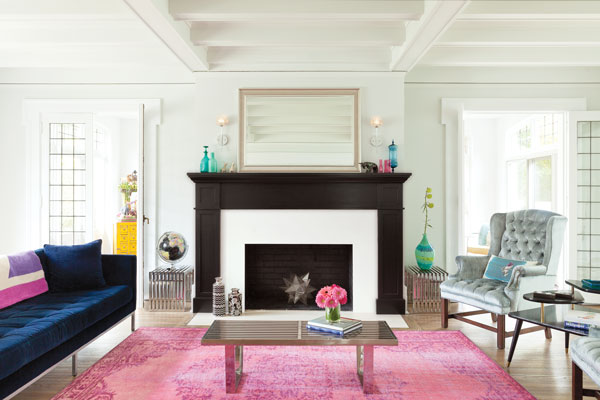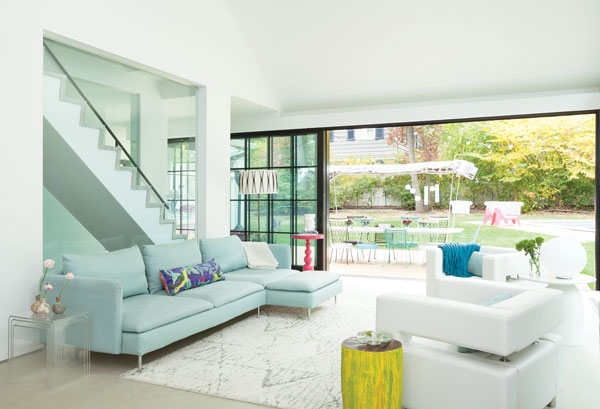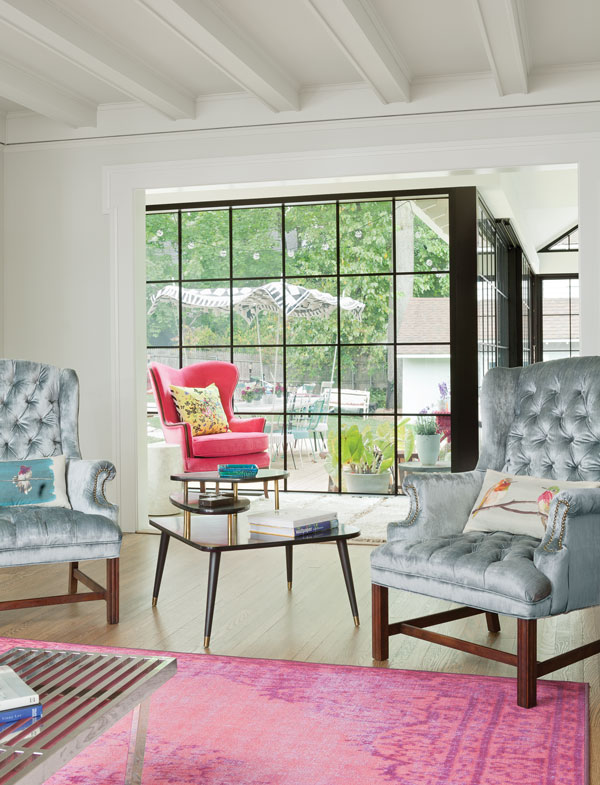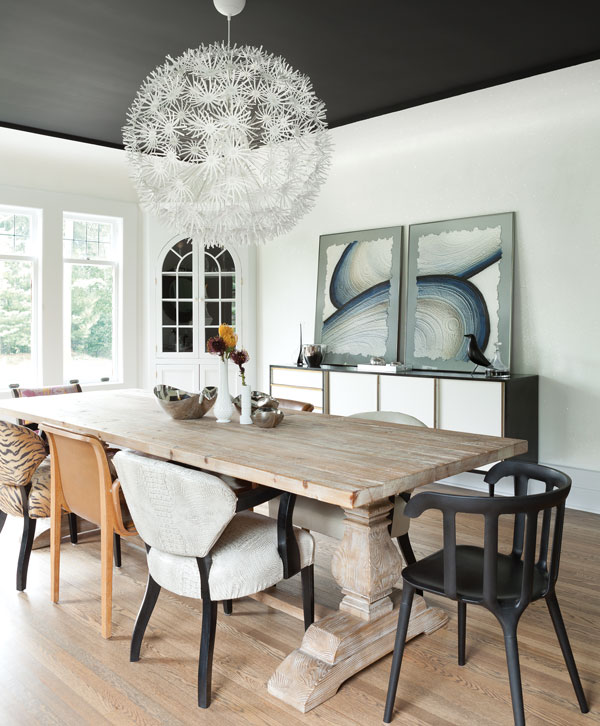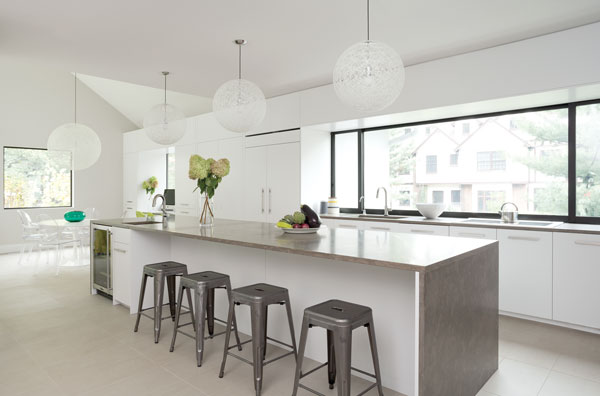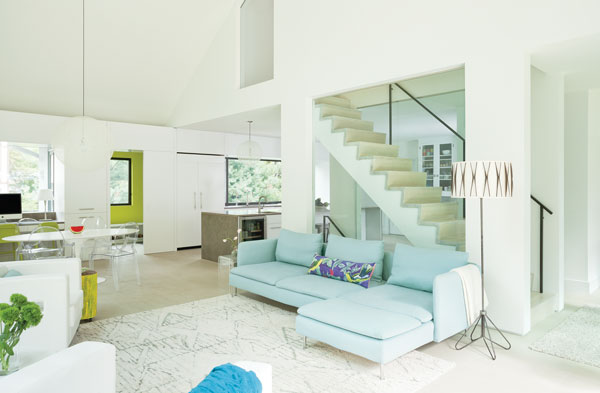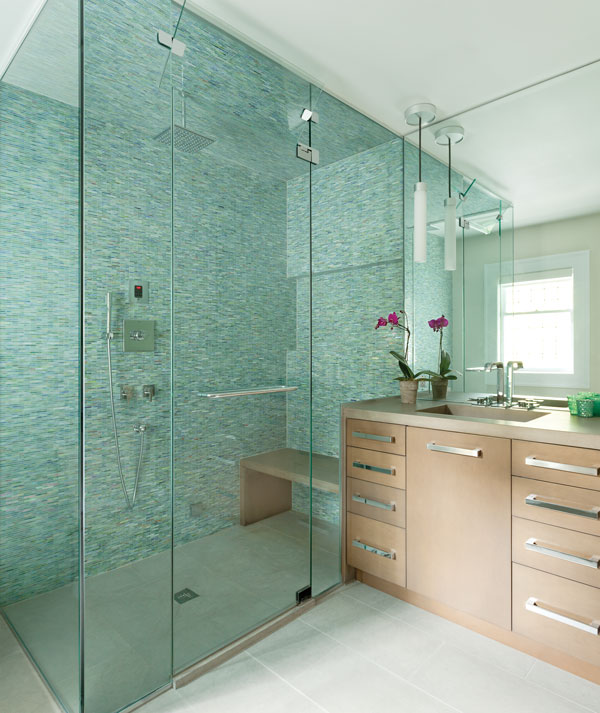Minimal Yet Colorful
Writer Denise S. Valenti | Photographer Emily Gilbert | Designer Rachael Grochowski, RA, NCARB | Architect Rachael Grochowski, RA, NCARB | Location Montclair, NJFuchsia, lime and teal punctuate the sedate design of a Montclair home.
Zoom in anywhere on an English garden and you’ll spot all the detail that has inspired chintz and toiles and traditional rooms for generations. Zoom out and you’re left with something far more minimalist, even potentially modern: bright bursts of color amidst strict order and form.
There are harmony and beauty in the essence of the garden just as there are in the particulars. And it’s that essence that is captured in a classic Montclair, New Jersey stucco home reimagined by Rachael Grochowski, RA, NCARB and principal of RHG Architecture+Design in Montclair.
Homeowners Sarah and Giles Colwell, both natives of England, have known Grochowski for years. When they were ready to seek a new residence, they asked her to accompany them on their hunt. Both an architect and interior designer, Grochowski advised the couple on the potential in each home they considered. They had been looking for something that wouldn’t require a lot of work, but they purchased their Craftsman Colonial-style house in Montclair anyway because of the location, price and potential. “They had strong desires,” Grochowski says. “This one could be customized to their family’s needs.”
The project Grochowski proposed married the traditional architecture of the home with a modern aesthetic and the family’s preferred European style of living. “They like modern design, but they have respect for the traditions of the original house,” Grochowski says.
Making Connections
Grochowski’s plan for the Colwell home centered on a 725-square-foot addition that creates a seamless progression between the old architecture and the new. A glass walkway, with windows mimicking the home’s original leaded glass panes, wraps around the back of the house. But the highlight is undoubtedly a 12-foot wide, double sliding door in the new family room that opens directly to the garden and pool. Whether the glass is opened or closed, it creates a direct link with the outdoors. “As an architect and a designer, I find that very comforting,” Grochowski says. “Connecting the outside to the inside is really valuable to a person’s well being.”
It also reflects the Colwells’ love of English gardens, as does the entire interior design in its tonal variety and textures. The overall aesthetic, both in the older and newer parts of the house, is unquestionably modern, with graphic elements and pops of color. Three colors in particular are used throughout: fuchsia, lime and teal. They are hues found in the most summery and cheerful garden bed, and they add equal delight within the home itself.
Sometimes the colors appear unexpectedly in the fabric of an armchair or the form of a side table. In other places they make a bolder statement. The mudroom, which is visible from the kitchen and family room, is painted lime green. When its door is open, it provides a fun accent that connects visually to the furnishings in the adjacent rooms. However, when guests arrive, the door can be closed to conceal the family’s personal belongings. “We call it The Lion, the Witch and the Wardrobe door,” Grochowski says, referring to the classic children’s book.
Valuing Color
The living room is a study not only in color use, but the importance of color value (how light or dark it reads). The design began with the mantel, which was undersized for the home. Grochowski had the mantel rebuilt to the proper scale with traditional detail, but she gave it a more modern appearance by painting it high-gloss black and installing a white stone surround. With an all-white room around it, plus light pouring in from the windows, the colors needed to provide some balance. “The dark blue sofa we thought was really good to ground the front of the house,” Grochowski says. “It became very graphic.”
“There’s also a relationship to the windows beyond,” she adds, referencing the leaded-glass doors on both sides of the mantel. “The color balances that out. You can’t have everything wispy.”
Sarah Colwell chose the pink rug. As the sole woman in a house of men, she wanted some femininity in the space. Colwell is an avid antiquer and picked up many of the home’s furnishings at garage and estate sales. She then consulted with Grochowski about where a piece might fit or what fabrics would look best when reupholstering.
Having been friends with Grochowski for so long, she was apprehensive about their collaboration on such a large project. “I shouldn’t have questioned it at all because she’s such a professional,” Colwell says of Grochowski.
Colwell was thrilled with the results, which are far different than she expected. For one thing, the scale of the home allowed for a generous addition that didn’t dwarf the original architecture. “It feels this has always been here,” she says. “That’s strange given that this is a contemporary addition.”
She also delighted in Grochowski’s modern twist on the classic architecture. “It’s what I wanted but a million times better,” she says. “I needed a little magic everywhere in the house. Every room has something special. She understood that. There’s a lot of joy in the house. It’s a very happy house.”
For the Colwells, it’s the sort of happiness evoked by a garden in full bloom.
Denise S. Valenti, a regular contributor to Design NJ, is a Cranford-based writer.

